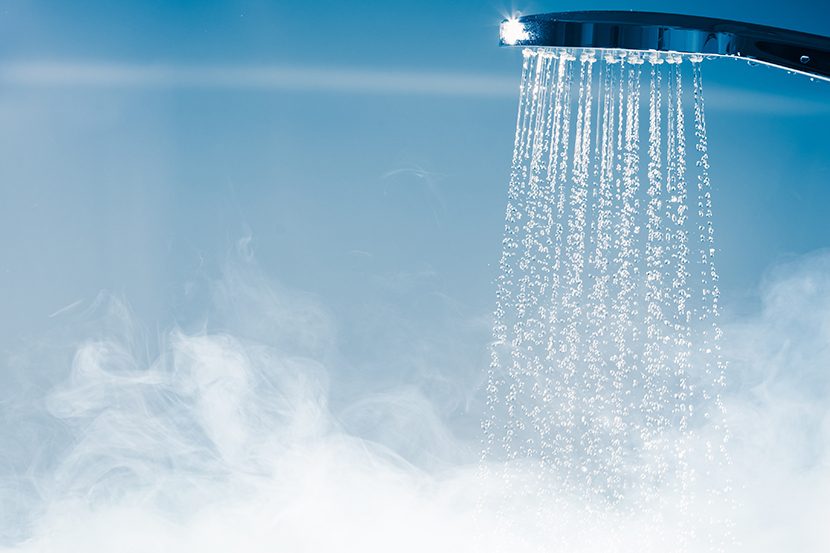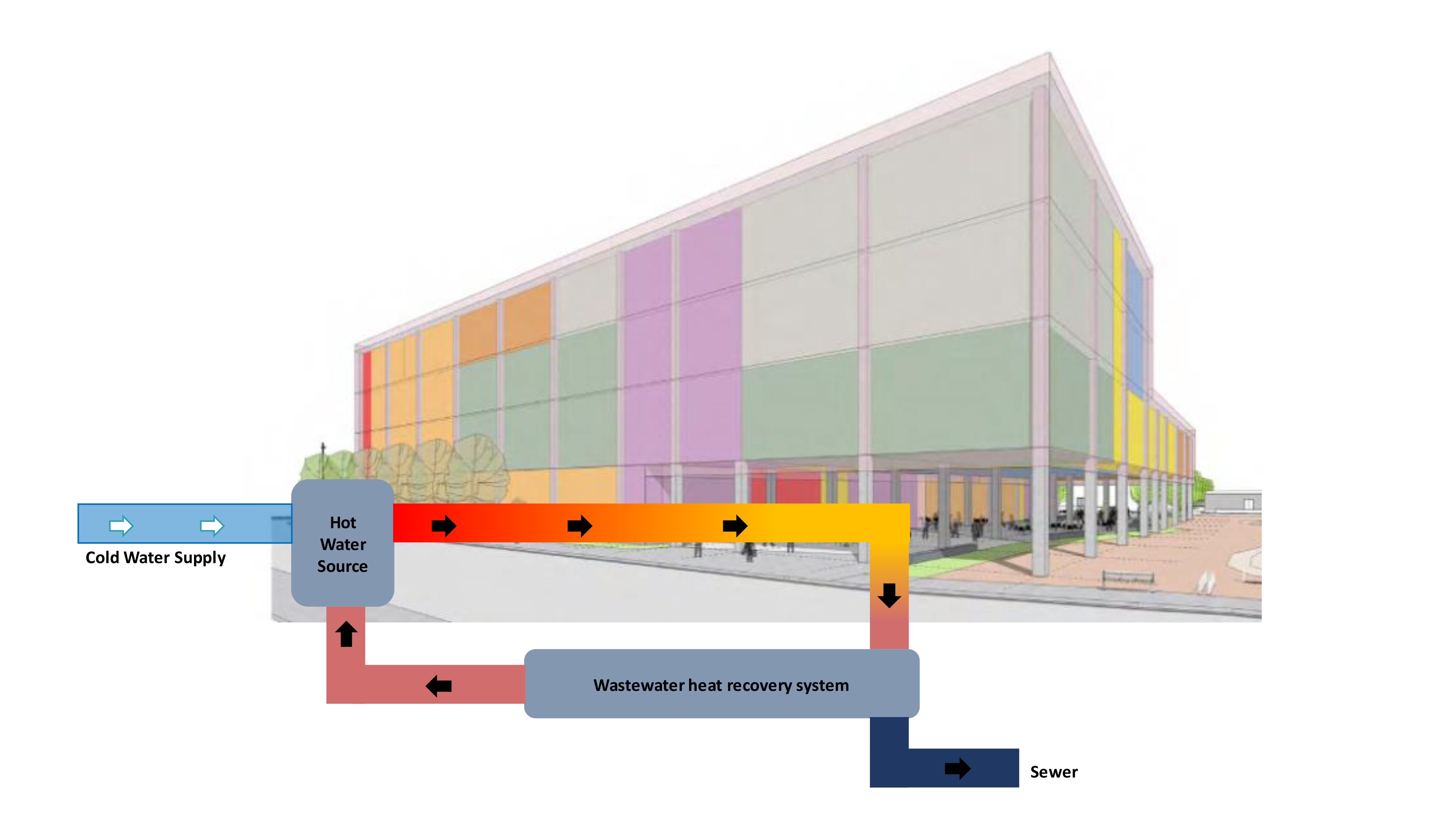Heat Pumps, Wastewater Heat Recovery for Energy-Efficient Plumbing System Design
Local jurisdictions are enacting aggressive energy-efficiency requirements, driving toward electrification of buildings and decarbonization.

The past five years brought with them a rapid change in how building owners approach domestic hot water (DHW) generation, especially in multifamily buildings. With increased attention to efficiency, reducing on-site greenhouse gas emissions, and a strong desire to reduce the cost of utilities, heat pumps have begun to explode onto the plumbing scene.
With solutions that work at all scales, heat pumps represent the biggest change in the plumbing industry since the introduction of condensing boilers. They bring with them nuanced design that every plumbing engineer and installer needs to know.
From coast to coast and in many states and cities in between, local jurisdictions are enacting aggressive energy-efficiency requirements, building performance standards and reach codes (optional construction energy-efficiency standards that exceed the state’s mandatory requirements) that are driving toward electrification of buildings and decarbonization (see Figure 1).

These efficiency targets necessitate advanced technology, and heat pumps fit the bill perfectly.
Recently passed federal legislation is bringing increased tax incentives to the marketplace, supporting widescale adoption of heat pump technology for not only DHW generation but space heating and cooling as well. Although not new from a technology standpoint, continued improvements in heat pump efficiency now make it a viable technology in nearly every climate zone.
When compared to traditional electric water heaters, energy savings can be significant.
What are Heat Pumps?
Unlike their combustion-based counterparts, heat pumps do not rely on the burning of fossil fuels to produce heat. Instead, heat pumps take advantage of the vapor compression cycle to move heat from one location to another. Unlike electric resistance heating elements, the electrical input into a heat pump is used primarily to operate a compressor, which provides the work input into the cycle. Depending on the efficiency of the system, a very small portion of the electrical input is converted directly into heat.
As mentioned, heat pumps are primarily designed to move heat from one location to another, and they are very efficient at doing this. Typically, heat pumps have a coefficient of performance (COP) ranging from 2.5 to more than 4 COP. Compare this to the effective efficiency of a boiler, which ranges from 0.85 to 0.97, depending on whether it is designed for condensing — heat pumps are often many more times as efficient.
The source of energy that the heat pump is pulling from, together with the medium of that source, begins to help us categorize the types of heat pumps used in DHW applications (see Figure 2).

• Air-source heat pumps. As the name implies, they use ambient outside air as the source of their heat. Heat pumps use a cold refrigerant working through a coil to extract heat from the ambient air. The compressor then compresses the refrigerant, forcing the temperature and pressure to rise. The hot refrigerant is then passed through a heat exchanger or coil, where it is used to heat water.
The now cooled but still high-pressure refrigerant passes through an expansion valve, where the pressure is released, causing the temperature of the refrigerant to drop. The cold refrigerant then rejects the cooling to the atmosphere and is now ready to repeat the cycle. The colder the ambient temperature, the harder the heat pump will work to extract heat from the air, which reduces the COP of the heat pump.
As ambient temperatures fall, the capacity of the heat pump decreases. Both factors mean that heat pump design, refrigerant selection and equipment selection are crucial to developing a successful and cost-effective DHW solution (see Figure 3).

• Water-source heat pumps. Similar to their air-source cousins, they still rely on a vapor compression cycle to move heat from a source to a sink. However, unlike air-source heat pumps, water-source heat pumps rely on some form of a water-distribution network as the source of heat. The water sources vary significantly, depending on the scale and type of application.
They can be connected to ground-loop heat exchangers, condenser water loops, and even building hydronic cooling systems, acting as a heat recovery heat pump and providing free chilled water to the building while simultaneously providing DHW. As water has a higher heat capacity and lower transport energy, water-source heat pumps have the potential to be significantly more efficient. Their flexibility, especially in large-scale developments and mixed-use buildings, makes them an excellent choice for high-efficiency systems.
Source Temperature Matters
As noted earlier, for DHW applications, the higher the source temperature (also known as quality), the higher the efficiency of the heat pump. Identifying high-temperature sources on a project will lead to even higher efficiency and increased savings in utility bills.
For example, an air-source heat pump located in a relief air plenum of a convention center in a cold climate will operate significantly more efficiently than if placed outdoors. High-temperature sources and heat recovery options need to be the first place engineers look when designing heat-pump DHW systems.
In multifamily buildings where the majority of DHW goes toward showering and laundry end-uses, the best heat source for the heat pump is actually the sanitary waste leaving the building. Even with water-efficient plumbing fixtures, Americans still use, on average, 60 gallons of water a day; roughly half of that water is heated for showers, sinks, washing dishes and laundry.
The wastewater going down the drain still contains energy from warm water use. This energy can be captured using wastewater heat pump system technology. As the name implies, the heat pump cools down the warm wastewater, significantly improving efficiency while reducing greenhouse gas emissions (see Figure 4).

The challenge with wastewater heat recovery, however, is the wastewater source is not always constant. To make the system effective, wastewater from the plumbing fixtures is directed to an on-site tank before leaving the site. Wastewater in the tank is then screened for solids before being pumped into the wastewater recovery heat pump system.
The screened wastewater then passes through a heat exchanger that works with the heat pump to heat domestic water on the other side for building use. Once the energy is pulled from the wastewater, it is blended back with the separated solids and continues its way down to the sewer system. Because the wastewater leaving the building is often upwards of 75 F, a very high-quality source temperature, these systems can return a COP of 4 year-round, regardless of climate, resulting in significant utility cost savings.
Carbon Emission Reduction
However, aren’t you burning fossil fuels somewhere else to make electricity, and isn’t that just as bad?
As utility grids rapidly increase their mix of electricity derived from zero-carbon renewable sources, the operational carbon footprint of heat pump water heaters continues to decline and will continue to do so every year. Because heat pump water heaters are so efficient, they already beat combustion boilers in carbon emission reduction in most states today.
In states such as California or Washington with exceptionally green grids, switching to a heat pump water heater today, even without additional efficiency measures, can reduce operational carbon emissions by more than 40% for DHW systems (see Figure 5).

Even in states with dirtier electrical grids, heat pump water heaters can still reduce carbon emissions. In these states, focusing on heat recovery strategies and high-efficiency equipment is especially important. Pairing these systems with on-site renewable energy systems such as solar photovoltaic systems can provide significant carbon savings.
In addition, such combinations help insulate building owners against unpredictable utility costs and inflationary pressures, providing both stability and cost savings.
In an upcoming article, join us as we walk through the process of designing heat pump DHW systems from single-pass to multi-pass, from central to distributed systems. We’ll also explore why DHW storage pairs perfectly with heat pump water heaters to provide reduced first costs and increased efficiency, and allows building owners to take advantage of load-shifting to save even more money while reducing emissions.
Stet Sanborn is a principal, licensed architect, and the mechanical engineering discipline leader for SmithGroup’s San Francisco office, where he leads decarbonization efforts and the design of cost-effective net-zero carbon buildings, campuses and districts.
Lowell Manalo is the West Region’s plumbing discipline leader at SmithGroup. He is a member of the American Society of Plumbing Engineers and has more than 20 years of experience designing plumbing systems for various building types.




